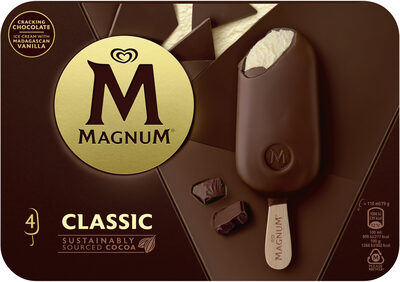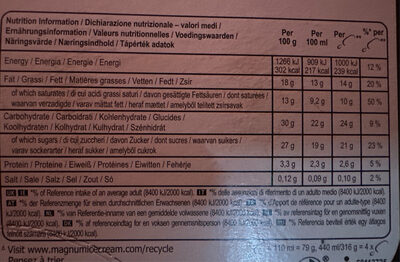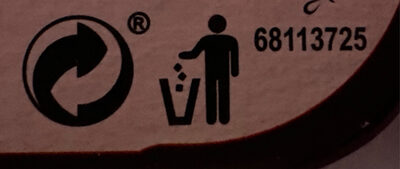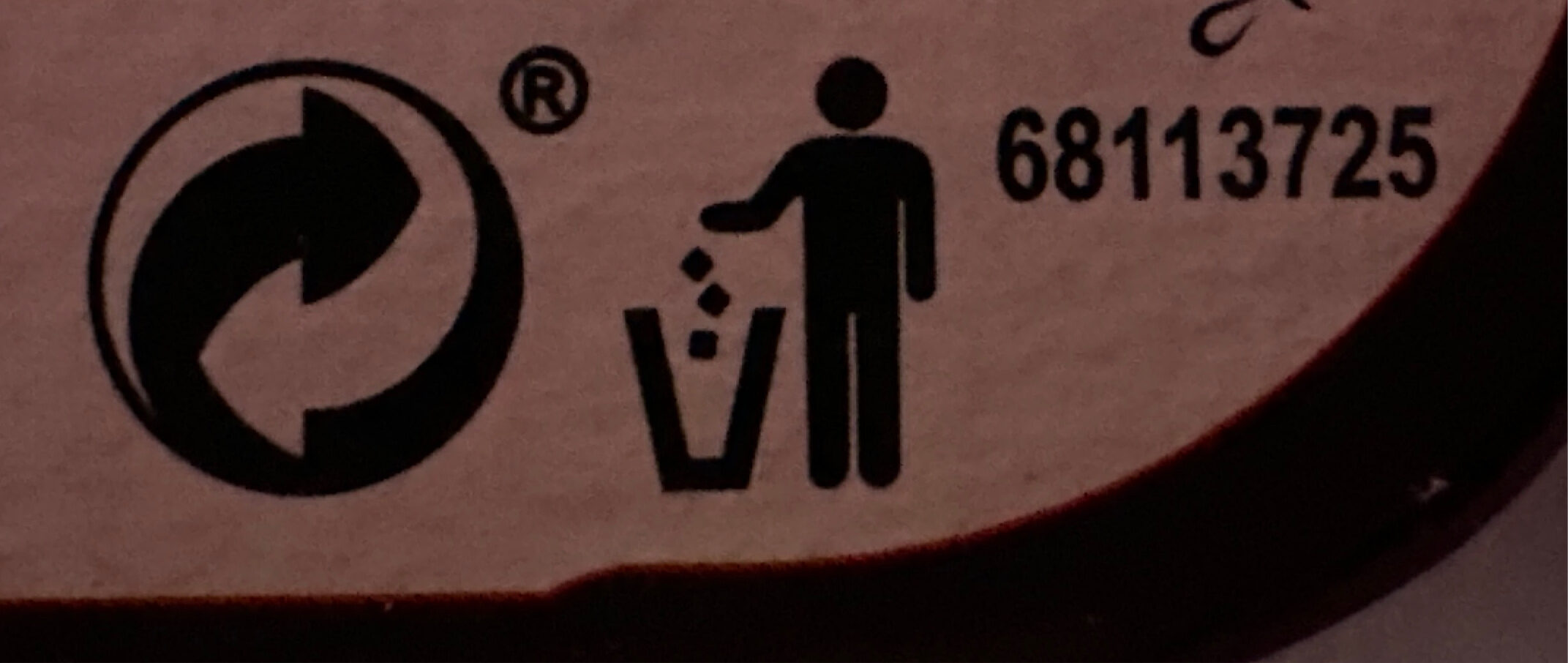Help us make food transparency the norm!
As a non-profit organization, we depend on your donations to continue informing consumers around the world about what they eat.
The food revolution starts with you!
MAGNUM Glace Bâtonnet Classic 4x110ml - Miko - 316 g
MAGNUM Glace Bâtonnet Classic 4x110ml - Miko - 316 g
This product page is not complete. You can help to complete it by editing it and adding more data from the photos we have, or by taking more photos using the app for Android or iPhone/iPad. Thank you!
×
Some of the data for this product has been provided directly by the manufacturer Unilever France.
Streckkod: 8712566328352 (EAN / EAN-13)
Vanligt namn: Glass med vanilj från Madagascar och överdrag av mjölkchoklad (26%)
Kvantitet: 316 g
Förpackning: Plast, en:Bag, en:Box, Kartong, Film, en:Frozen, en:Sleeve, en:Wrapper, en:Card-box, en:Container, fr:Point vert, fr:Tidyman wastebasket
Varumärken: Miko, Unilever, Magnum, Fairy
Kategorier: Efterrätter, Fryst mat, Frysta efterrätter, Glass och sorbet, Glass, en:Ice cream bars, en:Vanilla ice cream bars
Etiketter, certifieringar, utmärkelser:
Fair trade, Glutenfri, Fairtrade International, en:Green Dot, Max Havelaar, en:Rainforest Alliance, Rainforest Alliance Cocoa



Origin of the product and/or its ingredients: Europe
Länk till produktsidan på producentens officiella webbplats: http://www.mymagnum.be/fr-BE/product/det...
Butiker: Cora, Irma.dk, Franprix, Magasins U, carrefour.fr
Länder där såld: Österrike, Belgien, Kanada, Danmark, Frankrike, Tyskland, Ungern, Irland, Italien, Nederländerna, Sverige, Schweiz, Storbritannien
Matching with your preferences
Hälsa
Ingredienser
-
25 ingredienser
skummjölk, socker, kakaosmör, vatten, kakaomassa, kokosolja, glukossirap, glukos-fruktossirap, helmjölkspulver, vasslepulver (mjölk), mjölkfett, emulgeringsmedel (E471, sojalecitin, E476), vaniljstångbitar, stabiliseringsmedel (E410, E412, E407), naturlig vaniljarom (mjölk), arom, färgämne (E160a)Allergener: Mjölk, SojaSpår: Nötter
Food processing
-
Ultra processed foods
Elements that indicate the product is in the 4 - Ultra bearbetade livsmedel och drycker group:
- Tillsats: E160a - Karoten
- Tillsats: E322 - Lecitiner
- Tillsats: E407 - Karragenan
- Tillsats: E410 - E410 food additive
- Tillsats: E412 - Guarkärnmjöl
- Tillsats: E471 - Mono- och diglycerider av fettsyror
- Tillsats: E476 - Polyglycerolpolyricinoleat
- Ingrediens: Färg
- Ingrediens: Emulgeringsmedel
- Ingrediens: Arom
- Ingrediens: Glukos
- Ingrediens: Glukossirap
- Ingrediens: Laktos
- Ingrediens: Mjölkprotein
Food products are classified into 4 groups according to their degree of processing:
- Obearbetade eller minimalt bearbetade livsmedel
- Bearbetade kulinariska ingredienser
- Halvfabrikat
- Ultra processed foods
The determination of the group is based on the category of the product and on the ingredients it contains.
Tillsatser
-
E160a - Karoten
Carotene: The term carotene -also carotin, from the Latin carota, "carrot"- is used for many related unsaturated hydrocarbon substances having the formula C40Hx, which are synthesized by plants but in general cannot be made by animals -with the exception of some aphids and spider mites which acquired the synthesizing genes from fungi-. Carotenes are photosynthetic pigments important for photosynthesis. Carotenes contain no oxygen atoms. They absorb ultraviolet, violet, and blue light and scatter orange or red light, and -in low concentrations- yellow light. Carotenes are responsible for the orange colour of the carrot, for which this class of chemicals is named, and for the colours of many other fruits, vegetables and fungi -for example, sweet potatoes, chanterelle and orange cantaloupe melon-. Carotenes are also responsible for the orange -but not all of the yellow- colours in dry foliage. They also -in lower concentrations- impart the yellow coloration to milk-fat and butter. Omnivorous animal species which are relatively poor converters of coloured dietary carotenoids to colourless retinoids have yellowed-coloured body fat, as a result of the carotenoid retention from the vegetable portion of their diet. The typical yellow-coloured fat of humans and chickens is a result of fat storage of carotenes from their diets. Carotenes contribute to photosynthesis by transmitting the light energy they absorb to chlorophyll. They also protect plant tissues by helping to absorb the energy from singlet oxygen, an excited form of the oxygen molecule O2 which is formed during photosynthesis. β-Carotene is composed of two retinyl groups, and is broken down in the mucosa of the human small intestine by β-carotene 15‚15'-monooxygenase to retinal, a form of vitamin A. β-Carotene can be stored in the liver and body fat and converted to retinal as needed, thus making it a form of vitamin A for humans and some other mammals. The carotenes α-carotene and γ-carotene, due to their single retinyl group -β-ionone ring-, also have some vitamin A activity -though less than β-carotene-, as does the xanthophyll carotenoid β-cryptoxanthin. All other carotenoids, including lycopene, have no beta-ring and thus no vitamin A activity -although they may have antioxidant activity and thus biological activity in other ways-. Animal species differ greatly in their ability to convert retinyl -beta-ionone- containing carotenoids to retinals. Carnivores in general are poor converters of dietary ionone-containing carotenoids. Pure carnivores such as ferrets lack β-carotene 15‚15'-monooxygenase and cannot convert any carotenoids to retinals at all -resulting in carotenes not being a form of vitamin A for this species-; while cats can convert a trace of β-carotene to retinol, although the amount is totally insufficient for meeting their daily retinol needs.Källa: Wikipedia (Engelska)
-
E322 - Lecitiner
Lecithin: Lecithin -UK: , US: , from the Greek lekithos, "egg yolk"- is a generic term to designate any group of yellow-brownish fatty substances occurring in animal and plant tissues, which are amphiphilic – they attract both water and fatty substances -and so are both hydrophilic and lipophilic-, and are used for smoothing food textures, dissolving powders -emulsifying-, homogenizing liquid mixtures, and repelling sticking materials.Lecithins are mixtures of glycerophospholipids including phosphatidylcholine, phosphatidylethanolamine, phosphatidylinositol, phosphatidylserine, and phosphatidic acid.Lecithin was first isolated in 1845 by the French chemist and pharmacist Theodore Gobley. In 1850, he named the phosphatidylcholine lécithine. Gobley originally isolated lecithin from egg yolk—λέκιθος lekithos is "egg yolk" in Ancient Greek—and established the complete chemical formula of phosphatidylcholine in 1874; in between, he had demonstrated the presence of lecithin in a variety of biological matters, including venous blood, in human lungs, bile, human brain tissue, fish eggs, fish roe, and chicken and sheep brain. Lecithin can easily be extracted chemically using solvents such as hexane, ethanol, acetone, petroleum ether, benzene, etc., or extraction can be done mechanically. It is usually available from sources such as soybeans, eggs, milk, marine sources, rapeseed, cottonseed, and sunflower. It has low solubility in water, but is an excellent emulsifier. In aqueous solution, its phospholipids can form either liposomes, bilayer sheets, micelles, or lamellar structures, depending on hydration and temperature. This results in a type of surfactant that usually is classified as amphipathic. Lecithin is sold as a food additive and dietary supplement. In cooking, it is sometimes used as an emulsifier and to prevent sticking, for example in nonstick cooking spray.Källa: Wikipedia (Engelska)
-
E322i - Lecitin
Lecithin: Lecithin -UK: , US: , from the Greek lekithos, "egg yolk"- is a generic term to designate any group of yellow-brownish fatty substances occurring in animal and plant tissues, which are amphiphilic – they attract both water and fatty substances -and so are both hydrophilic and lipophilic-, and are used for smoothing food textures, dissolving powders -emulsifying-, homogenizing liquid mixtures, and repelling sticking materials.Lecithins are mixtures of glycerophospholipids including phosphatidylcholine, phosphatidylethanolamine, phosphatidylinositol, phosphatidylserine, and phosphatidic acid.Lecithin was first isolated in 1845 by the French chemist and pharmacist Theodore Gobley. In 1850, he named the phosphatidylcholine lécithine. Gobley originally isolated lecithin from egg yolk—λέκιθος lekithos is "egg yolk" in Ancient Greek—and established the complete chemical formula of phosphatidylcholine in 1874; in between, he had demonstrated the presence of lecithin in a variety of biological matters, including venous blood, in human lungs, bile, human brain tissue, fish eggs, fish roe, and chicken and sheep brain. Lecithin can easily be extracted chemically using solvents such as hexane, ethanol, acetone, petroleum ether, benzene, etc., or extraction can be done mechanically. It is usually available from sources such as soybeans, eggs, milk, marine sources, rapeseed, cottonseed, and sunflower. It has low solubility in water, but is an excellent emulsifier. In aqueous solution, its phospholipids can form either liposomes, bilayer sheets, micelles, or lamellar structures, depending on hydration and temperature. This results in a type of surfactant that usually is classified as amphipathic. Lecithin is sold as a food additive and dietary supplement. In cooking, it is sometimes used as an emulsifier and to prevent sticking, for example in nonstick cooking spray.Källa: Wikipedia (Engelska)
-
E407 - Karragenan
Carrageenan: Carrageenans or carrageenins - karr-ə-gee-nənz, from Irish carraigín, "little rock"- are a family of linear sulfated polysaccharides that are extracted from red edible seaweeds. They are widely used in the food industry, for their gelling, thickening, and stabilizing properties. Their main application is in dairy and meat products, due to their strong binding to food proteins. There are three main varieties of carrageenan, which differ in their degree of sulfation. Kappa-carrageenan has one sulfate group per disaccharide, iota-carrageenan has two, and lambda-carrageenan has three. Gelatinous extracts of the Chondrus crispus -Irish moss- seaweed have been used as food additives since approximately the fifteenth century. Carrageenan is a vegetarian and vegan alternative to gelatin in some applications or may be used to replace gelatin in confectionery.Källa: Wikipedia (Engelska)
-
E410 - E410 food additive
Locust bean gum: Locust bean gum -LBG, also known as carob gum, carob bean gum, carobin, E410- is a thickening agent and a gelling agent used in food technology.Källa: Wikipedia (Engelska)
-
E412 - Guarkärnmjöl
Guar gum: Guar gum, also called guaran, is a galactomannan polysaccharide extracted from guar beans that has thickening and stabilizing properties useful in the food, feed and industrial applications. The guar seeds are mechanically dehusked, hydrated, milled and screened according to application. It is typically produced as a free-flowing, off-white powder.Källa: Wikipedia (Engelska)
-
E471 - Mono- och diglycerider av fettsyror
Mono- and diglycerides of fatty acids: Mono- and diglycerides of fatty acids -E471- refers to a food additive composed of diglycerides and monoglycerides which is used as an emulsifier. This mixture is also sometimes referred to as partial glycerides.Källa: Wikipedia (Engelska)
-
E476 - Polyglycerolpolyricinoleat
Polyglycerol polyricinoleate: Polyglycerol polyricinoleate -PGPR-, E476, is an emulsifier made from glycerol and fatty acids -usually from castor bean, but also from soybean oil-. In chocolate, compound chocolate and similar coatings, PGPR is mainly used with another substance like lecithin to reduce viscosity. It is used at low levels -below 0.5%-, and works by decreasing the friction between the solid particles -e.g. cacao, sugar, milk- in molten chocolate, reducing the yield stress so that it flows more easily, approaching the behaviour of a Newtonian fluid. It can also be used as an emulsifier in spreads and in salad dressings, or to improve the texture of baked goods. It is made up of a short chain of glycerol molecules connected by ether bonds, with ricinoleic acid side chains connected by ester bonds. PGPR is a yellowish, viscous liquid, and is strongly lipophilic: it is soluble in fats and oils and insoluble in water and ethanol.Källa: Wikipedia (Engelska)
Ingrediensanalys
-
Kan innehålla palmolja
Ingredienser som kan innehålla palmolja: Smörfett, E471, E160a
-
Icke-vegan
Non-vegan ingredients: en:Reconstituted skimmed milk, Helmjölkspulver, en:Lactose and milk proteins, Smörfett, Mjölk
-
Kanske Vegetariskt
Ingredients that may not be vegetarian: E471, Arom, E160a
-
Details of the analysis of the ingredients
fr: LAIT écrémé réhydraté, sucre, beurre de cacao¹, eau, huile de coco, pâte de cacao¹, sirop de glucose, sirop de glucose-fructose, LAIT en poudre entier, LACTOSE et protéines de LAIT, BEURRE concentré, émulsifiants (lécithine de SOJA, e476, e471), gousses de vanille épuisées broyées, stabilisants (e407, e410, e412), arôme naturel de vanille¹ (dont LAIT), arôme, colorant (e160a)- LAIT écrémé réhydraté -> en:reconstituted-skimmed-milk - vegan: no - vegetarian: yes - ciqual_proxy_food_code: 19051 - percent_min: 5.88235294117647 - percent_max: 100
- sucre -> en:sugar - vegan: yes - vegetarian: yes - ciqual_proxy_food_code: 31016 - percent_min: 0 - percent_max: 19
- beurre de cacao¹ -> en:cocoa-butter - vegan: yes - vegetarian: yes - ciqual_food_code: 16030 - percent_min: 0 - percent_max: 19
- eau -> en:water - vegan: yes - vegetarian: yes - ciqual_food_code: 18066 - percent_min: 0 - percent_max: 19
- huile de coco -> en:coconut-oil - vegan: yes - vegetarian: yes - from_palm_oil: no - ciqual_food_code: 16040 - percent_min: 0 - percent_max: 19
- pâte de cacao¹ -> en:cocoa-paste - vegan: yes - vegetarian: yes - ciqual_proxy_food_code: 16030 - percent_min: 0 - percent_max: 16.6666666666667
- sirop de glucose -> en:glucose-syrup - vegan: yes - vegetarian: yes - ciqual_proxy_food_code: 31016 - percent_min: 0 - percent_max: 14.2857142857143
- sirop de glucose-fructose -> en:glucose-fructose-syrup - vegan: yes - vegetarian: yes - ciqual_food_code: 31077 - percent_min: 0 - percent_max: 12.5
- LAIT en poudre entier -> en:whole-milk-powder - vegan: no - vegetarian: yes - ciqual_food_code: 19021 - percent_min: 0 - percent_max: 11.1111111111111
- LACTOSE et protéines de LAIT -> en:lactose-and-milk-proteins - vegan: no - vegetarian: yes - percent_min: 0 - percent_max: 10
- BEURRE concentré -> en:butterfat - vegan: no - vegetarian: yes - from_palm_oil: maybe - ciqual_food_code: 16401 - percent_min: 0 - percent_max: 9.09090909090909
- émulsifiants -> en:emulsifier - percent_min: 0 - percent_max: 8.33333333333333
- lécithine de SOJA -> en:soya-lecithin - vegan: yes - vegetarian: yes - ciqual_food_code: 42200 - percent_min: 0 - percent_max: 8.33333333333333
- e476 -> en:e476 - vegan: yes - vegetarian: yes - percent_min: 0 - percent_max: 4.16666666666667
- e471 -> en:e471 - vegan: maybe - vegetarian: maybe - from_palm_oil: maybe - percent_min: 0 - percent_max: 2.77777777777778
- gousses de vanille épuisées broyées -> en:exhausted-ground-vanilla-pod - vegan: yes - vegetarian: yes - percent_min: 0 - percent_max: 7.69230769230769
- stabilisants -> en:stabiliser - percent_min: 0 - percent_max: 7.14285714285714
- e407 -> en:e407 - vegan: yes - vegetarian: yes - percent_min: 0 - percent_max: 7.14285714285714
- e410 -> en:e410 - vegan: yes - vegetarian: yes - percent_min: 0 - percent_max: 3.57142857142857
- e412 -> en:e412 - vegan: yes - vegetarian: yes - percent_min: 0 - percent_max: 2.38095238095238
- arôme naturel de vanille¹ -> en:natural-vanilla-flavouring - vegan: yes - vegetarian: yes - percent_min: 0 - percent_max: 5
- dont LAIT -> en:milk - vegan: no - vegetarian: yes - ciqual_proxy_food_code: 19051 - percent_min: 0 - percent_max: 5
- arôme -> en:flavouring - vegan: maybe - vegetarian: maybe - percent_min: 0 - percent_max: 5
- colorant -> en:colour - percent_min: 0 - percent_max: 5
- e160a -> en:e160a - vegan: maybe - vegetarian: maybe - from_palm_oil: maybe - percent_min: 0 - percent_max: 5
Näring
-
Poor nutritional quality
⚠ ️Varning: mängden fibrer är inte angiven, eventuella positiv inverkan på betyget kunde inte beaktas.⚠ ️Warning: the amount of fruits, vegetables and nuts is not specified on the label, it was estimated from the list of ingredients: 0This product is not considered a beverage for the calculation of the Nutri-Score.
Positiva poäng: 0
- Proteiner: 1 / 5 (värde: 2.3, avrundat värde: 2.3)
- Fiber: 0 / 5 (värde: 0, avrundat värde: 0)
- Frukt, grönsaker, nötter och raps- / valnöt- / olivoljor: 0 / 5 (värde: 0, avrundat värde: 0)
Negativa poäng: 15
- Energi: 2 / 10 (värde: 909, avrundat värde: 909)
- Socker: 4 / 10 (värde: 19, avrundat värde: 19)
- Mättat fett: 9 / 10 (värde: 9.2, avrundat värde: 9.2)
- Natrium: 0 / 10 (värde: 36, avrundat värde: 36)
The points for proteins are not counted because the negative points are greater or equal to 11.
Näringsvärde: (15 - 0)
Nutri-Score:
-
Näringsvärden
-
Fett i måttlig kvantitet (13%)
What you need to know- A high consumption of fat, especially saturated fats, can raise cholesterol, which increases the risk of heart diseases.
Recommendation: Limit the consumption of fat and saturated fat- Choose products with lower fat and saturated fat content.
-
Mättat fett i hög kvantitet (9.2%)
What you need to know- A high consumption of fat, especially saturated fats, can raise cholesterol, which increases the risk of heart diseases.
Recommendation: Limit the consumption of fat and saturated fat- Choose products with lower fat and saturated fat content.
-
Sockerarter i hög kvantitet (19%)
What you need to know- A high consumption of sugar can cause weight gain and tooth decay. It also augments the risk of type 2 diabetes and cardio-vascular diseases.
Recommendation: Limit the consumption of sugar and sugary drinks- Sugary drinks (such as sodas, fruit beverages, and fruit juices and nectars) should be limited as much as possible (no more than 1 glass a day).
- Choose products with lower sugar content and reduce the consumption of products with added sugars.
-
Salt i låg kvantitet (0.09%)
What you need to know- A high consumption of salt (or sodium) can cause raised blood pressure, which can increase the risk of heart disease and stroke.
- Many people who have high blood pressure do not know it, as there are often no symptoms.
- Most people consume too much salt (on average 9 to 12 grams per day), around twice the recommended maximum level of intake.
Recommendation: Limit the consumption of salt and salted food- Reduce the quantity of salt used when cooking, and don't salt again at the table.
- Limit the consumption of salty snacks and choose products with lower salt content.
-
-
Näringsfakta
Näringsfakta Som såld
för 100 g / 100 mlSom såld
per portion (110 ml)Compared to: en:Ice cream bars Energi 909 kj
(217 kcal)1 000 kj
(239 kcal)−20 % Fett 13 g 14,3 g −24 % Mättat fett 9,2 g 10,1 g −16 % Kolhydrat 22 g 24,2 g −12 % Sockerarter 19 g 20,9 g −17 % Fiber ? ? Protein 2,3 g 2,53 g −27 % Salt 0,09 g 0,099 g −1 % Fruits‚ vegetables‚ nuts and rapeseed‚ walnut and olive oils (estimate from ingredients list analysis) 0 % 0 %
Miljö
-
Eco-Score B - Låg miljöpåverkan
The Eco-Score is an experimental score that summarizes the environmental impacts of food products.→ The Eco-Score was initially developped for France and it is being extended to other European countries. The Eco-Score formula is subject to change as it is regularly improved to make it more precise and better suited to each country.Life cycle analysis
-
Average impact of products of the same category: A (Score: 87/100)
Kategori: Ice cream, cone (normal size)
Kategori: Ice cream, cone (normal size)
- PEF environmental score: 0.22 (the lower the score, the lower the impact)
- including impact on climate change: 1.74 kg CO2 eq/kg of product
Stage Impact Jordbruk
56.4 %Bearbetar
18.3 %Förpackning
6.8 %Transportation
7.0 %Distribution
7.3 %Consumption
4.2 %
Bonuses and maluses
-
Labels with very high environmental benefits
Bonus: +20
-
Fairtrade International
Fair trade is an arrangement designed to help producers in developing countries achieve sustainable and equitable trade relationships. Members of the fair trade movement add the payment of higher prices to exporters, as well as improved social and environmental standards.
-
-
Missing origins of ingredients information
Malus: -5
⚠ ️ The origins of the ingredients of this product are not indicated.
If they are indicated on the packaging, you can modify the product sheet and add them.
If you are the manufacturer of this product, you can send us the information with our free platform for producers.
-
Packaging with a high impact
Malus: -15
Form Material Återvinning Impact 1 Box Kartong Recycle Låg Container Plast Recycle Hög 4 Bag Plast Recycler4 Hög 4 Stick Trä Recycle Medium Film Okänd Hög ⚠ ️ The information about the packaging of this product is not sufficiently precise (exact shapes and materials of all components of the packaging).⚠ ️ For a more precise calculation of the Eco-Score, you can modify the product page and add them.
If you are the manufacturer of this product, you can send us the information with our free platform for producers.
Eco-Score for this product
-
Impact for this product: B (Score: 79/100)
Produkt: MAGNUM Glace Bâtonnet Classic 4x110ml - Miko - 316 g
Life cycle analysis score: 87
Sum of bonuses and maluses: 0
Final score: 79/100 (The score of products with non-recyclable and non-biodegradable packaging materials is capped at 79 (grade B).)
-
Carbon footprint
-
Equal to driving 0.9 km in a petrol car
174 g CO² per 100g of product
The carbon emission figure comes from ADEME's Agribalyse database, for the category: Ice cream, cone (normal size) (Source: ADEME Agribalyse Database)
Stage Impact Jordbruk
60.7 %Bearbetar
12.4 %Förpackning
10.4 %Transportation
11.3 %Distribution
3.8 %Consumption
1.5 %
Förpackning
-
Packaging with a high impact
-
Packaging parts
1 x Box (Kartong)
Container (Plast)
4 x Stick (Trä)
4 x Bag (Plast)
Film
-
Packaging materials
Material % Packaging weight Packaging weight per 100 g of product Paper or cardboard Plast Total
-
Transportation
-
Origins of ingredients
Missing origins of ingredients information
⚠ ️ The origins of the ingredients of this product are not indicated.
If they are indicated on the packaging, you can modify the product sheet and add them.
If you are the manufacturer of this product, you can send us the information with our free platform for producers.Add the origins of ingredients for this product Add the origins of ingredients for this product
Etiketter
-
Fairtrade International
Fair trade is an arrangement designed to help producers in developing countries achieve sustainable and equitable trade relationships. Members of the fair trade movement add the payment of higher prices to exporters, as well as improved social and environmental standards.
Övrig information
Förberedelse: Sortez vos glaces du congélateur quelques minutes avant de les déguster, afin de profiter pleinement de leurs saveurs.
Conservation conditions: À conserver entre -25°C et -18°C
Kundservice: Magnum Relation Consommateurs, Unilever France, 20 rue des Deux Gares 92842 Rueil-Malmaison Cedex
Report a problem
-
Incomplete or incorrect information?
Category, labels, ingredients, allergens, nutritional information, photos etc.
If the information does not match the information on the packaging, please complete or correct it. Open Food Facts is a collaborative database, and every contribution is useful for all.
Datakällor
The manufacturer Unilever France uses Equadis to automatically transmit data and photos for its products.
Produkt tillagd den av kyzh
Senast ändrad produktsida på av org-unilever-france-gms.
Produktsida också redigerad av aleene, beniben, date-limite-app, davidepio, driveoff, ecoscore-impact-estimator, ennoia11, g123k, inf, kiliweb, magasins-u, mathias, openfoodfacts-contributors, packbot, roccait, scanparty-franprix-05-2016, sophiecool62, stephane, swipe-studio, tacinte, tacite, the-redburn, unilever-france, yuka.sY2b0xO6T85zoF3NwEKvlkNtUorkgTT_OS7myEGPy42lDbP0e45K7KvIKKs, yuka.sY2b0xO6T85zoF3NwEKvlnZtbubavwP7OUPixRWnx-2iP5vOXo5pv5XWbqs.
Last check of product page on av tacite.















